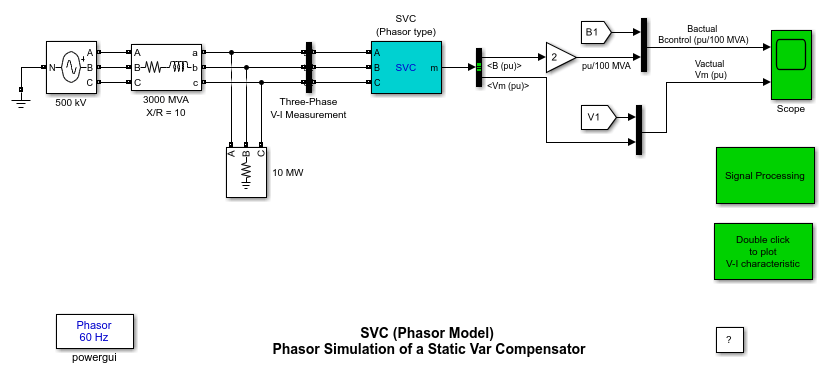Static Var Compensator (SVC) Phasor Model
This example shows steady-state and dynamic performance of the static var compensator model.
G. Sybille (Hydro-Quebec)

Description
A static var compensator (SVC) is used to regulate voltage on a 500 kV, 3000 MVA system. When system voltage is low the SVC generates reactive power (SVC capacitive). When system voltage is high it absorbs reactive power (SVC inductive). The SVC is rated +200 Mvar capacitive and 100 Mvar inductive. The Static Var Compensator block is a phasor model representing the SVC static and dynamic characteristics at the system fundamental frequency.
To see the SVC control parameters, open the SVC dialog box and select "Display Control parameters". The SVC is set in voltage regulation mode with a reference voltage Vref=1.0 pu. The voltage droop is 0.03 pu/ 200MVA, so that the voltage varies from 0.97 pu to 1.015 pu when the SVC current goes from fully capacitive to fully inductive. Double click now on the blue block to display the SVC V-I characteristic.
The actual SVC positive-sequence voltage (V1) and susceptance (B1) are measured inside the 'Signal Processing' subsystem, using the complex voltages Vabc and complex currents Iabc returned by the Three-Phase V-I Measurement block.
1. Dynamic Response of the SVC
The Three-Phase Programmable Voltage Source is used to vary the system voltage and observe the SVC performance. Initially the source is generating nominal voltage. Then, voltage is successively decreased (0.97 pu at t = 0.1 s), increased (1.03 pu at t = 0.4 s) and finally returned to nominal voltage (1 pu at t = 0.7 s).
Start the simulation and observe the SVC dynamic response to voltage steps on the Scope. Trace 1 shows the actual positive-sequence susceptance B1 and control signal output B of the voltage regulator. Trace 2 shows the actual system positive-sequence voltage V1 and output Vm of the SVC measurement system.
The SVC response speed depends on the voltage regulator integral gain Ki (Proportional gain Kp is set to zero), system strength (reactance Xn) and droop (reactance Xs). If the voltage measurement time constant and average time delay Td due to valve firing are neglected, the system can be approximated by a first order system having a closed loop time constant :
Tc= 1/(Ki*(Xn+Xs))
With given system parameters (Ki = 300; Xn = 0.0667 pu/200 MVA; Xs = 0.03 pu/200 MVA), Tc = 0.0345 s. If you increase the regulator gain or decrease the system strength, the measurement time constant and the valve firing delay Td will no longer be negligible and you will observe an oscillatory response and eventually unstability.
2. Measurement of Steady-State V-I Characteristic
In order to measure the SVC steady-state V-I characteristic, you will now program a slow variation of the source voltage. Open the Programmable Voltage Source menu and change the "Type of Variation" parameter to "Modulation". The modulation parameters are set to apply a sinusoidal variation of the positive-sequence voltage between 0.75 and 1.25 pu in 20 seconds. Change the stop time to 20 s and restart simulation. When simulation is completed, double click the blue block. The theoretical V-I characteristic is displayed (in red) together with the measured characteristic (in blue).